UPSC GS 1
Great Nicobar
- News: Recently, the Congress party demanded an “immediate suspension” of all clearances granted to NITI Aayog’s mega project on Great Nicobar Island.
- Great Nicobar Island:
-
- Great Nicobar is India’s southernmost point, part of the Andaman and Nicobar archipelago.
- Comprises around 600 islands.
-
- Communities:
-
- The island is home to two tribal communities — the Shompen and the Nicobarese.
- The Shompen, around 250 in total, mostly live in the interior forests and are relatively isolated from the rest of the population.
- They are predominantly hunter-gatherers and are classified as a Particularly Vulnerable Tribal Group within the list of Scheduled Tribes.
- The Nicobarese community practises farming and fishing.
-
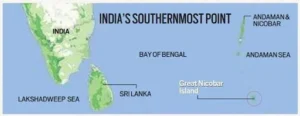
- Ecosystem:
-
- The Great Nicobar Island has tropical wet evergreen forests, mountain ranges reaching almost 650 m above sea level, and coastal plains.
- This island hosts numerous endangered and endemic species including the giant leatherback turtle, the Nicobar megapode, the Great Nicobar crake, the Nicobar crab-eating macaque, and the Nicobar tree shrew.
- The leatherback sea turtle is the island’s flagship species.
- It has an area of 910 sq km with mangroves and Pandan forests along its coast.
- The Island has two national parks (Campbell Bay National Park & Galathea National Park) and a biosphere reserve.
-
- Andaman and Nicobar Islands:
-
- The Andaman and Nicobar Islands are a cluster of about 836 islands in the eastern Bay of Bengal.
- These two groups of which are separated by the 150-km wide Ten Degree Channel.
- The Andaman Islands lie to the north of the channel, and the Nicobar Islands to the south.
-
Sucheta Kripalani
- News: June 25th was the birth anniversary of Sucheta Kripalani.
- Sucheta Kripalani: India’s First Woman Chief Minister
- Birth: June 25, 1908, Ambala.
- Role in Indian Independence Movement:
-
- Ideology: She was committed to the Gandhian ideology.
- Freedom Fighter: Sucheta Kripalani was an Indian freedom fighter and politician. She participated in satyagraha in Faizabad, imprisoned for nearly a year in 1940.
- All India Mahila Congress: Sucheta Kripalani was also the founder of the All India Mahila Congress.
- Role in the Quit India Movement: Worked underground to evade arrest. Eventually arrested in Patna and spent several months in jail in Lucknow.
-
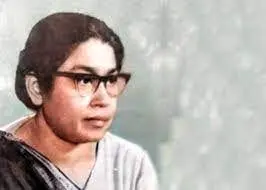
- Political Career:
-
- Chief Minister of Uttar Pradesh: Served from October 2, 1963, to March 13, 1967.
- Lok Sabha MP: Served until 1971.
- Constituent Assembly: One of the very few women elected to the Constituent Assembly of India. Represented the Kanpur constituency and was a member of the sub-committee that drafted the Indian Constitution.
-
- International Representation:
-
- United Nations: She was delegate to the United Nations General Assembly in 1949.
- International Labour Organisation: She also led the Indian delegation to the International Labour Organisation in 1961.
-
- Literary Contribution:
-
- “An Unfinished Autobiography“: In her book, Sucheta recounts the profound emotion she felt as a ten-year-old after the Jallianwala Bagh massacre.
-
Read more: Management of Nuclear Waste: Challenges and Mitigation | UPSC
Ambubachi Mela
- News: The doors of Kamakhya Temple, closed for the last four days on the occasion of Ambubachi Mela, opened recently with devotees thronging the seat of Shakti cult.
- Ambubachi Mela:
-
- It is an annual Hindu fair held at the historic Kamakhya Temple.
- It is celebrated during the monsoon season in the Assamese month of Ahaar (mid-June).
- It commemorates the yearly menstruation course of goddess Maa Kamakhya.
-
- Key Facts about Kamakhya Temple:
-
- Situated on Nilachal Hill, adjacent to the southern bank of the Brahmaputra River in Guwahati.
- One of the most revered centers of Tantric practices.
- Considered one of the oldest of the 51 Shakti Peethas in India.
- Modelled out of a combination of two styles: traditional Nagara (North Indian) and Saracenic (Mughal), known as the Nilachala Style of Architecture.
-
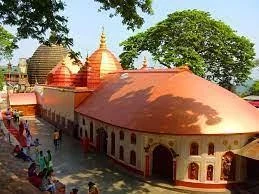
-
-
- Consists of five chambers:
- Garbhagriha: Sanctuary
- Antarala: Vestibule
- Jagan Mohan: Principal chamber
- Bhogmandir: Ritual chamber
- Natmandir: Opera hall for traditional dance and music performances
- Architectural Features:
- Main temple: Modified Saracenic dome.
- Antarala: Two-roofed design.
- Bhogmandir (Pancharatna): Five domes similar to the main temple.
- Natmandir: Shell-roof with apsidal end, similar to impermanent namghars (prayer halls) found in Assam.
-
Srikakulam
- News: Several historians, academics, writers, and heritage enthusiasts have been working diligently to restore the prominence of Srikakulam’s forgotten ancient history.
- Location: Srikakulam is a district in the state of Andhra Pradesh.
- Cultural Significance: Home to numerous prominent Buddhist sites, Neolithic-era caves, and some of the oldest temples in the state.
- Historical Background:
-
- It was once part of the Kalinga Dynasty.
- Later ruled by the Gajapati Kingdom during the medieval period.
- Came under the rule of the Eastern Chalukyas of Vengi.
- Also part of the Kakatiya and Vijayanagara empires.
-
- Buddhist Sites:
-
- Dantapuri and Salihundam: Salihundam has four stupas, relic caskets, and sculptures of Buddhist deities Mareechi and Tara.
- The remnants date from the 2nd century BC to the 12th century AD.
- Buddhism is believed to have spread to Sumatra and other far-eastern countries from here.
-
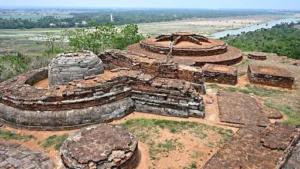
- Jainism Sites: Tangamayyakonda and Rottavalasa villages.
- Famous Temples:
-
- Arasavalli: The Sri Suryanarayana Swamy Temple, dedicated to the sun god.
- One of the two such temples, the other being the Konark Sun Temple in Odisha.
- Srimukhalingam: This temple was built in the Kalinga architectural style. Located by the Vamsadhara River. Dedicated to Lord Srimukha Lingeswara.
-
Saipan Island
- News: Better known for its sandy beaches, the tropical Pacific island of Saipan will soon host the final act of Julian Assange’s 14-year legal journey.
- Location:
-
- Situated in the Western Pacific Ocean.
- It is the capital of the Northern Mariana Islands (NMI), a US commonwealth.
- Begins roughly 70 km (44 miles) north of Guam and stretches across 14 islands.
-
- Historical Background:
-
- Former colonies of Spain, Germany, and Japan.
- The United States took control during World War II.
-
- Political Status:
-
- Part of the US, similar to Guam or Puerto Rico, without full statehood.
- Residents voted in 1975 to join the United States as a territory.
- Has a permanent delegate in the US House of Representatives, though they cannot vote.
-
- Geography:
-
- Highest point: Mount Tapochau.
-
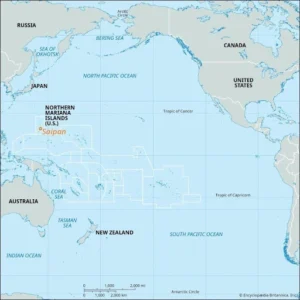
- Economy:
-
- Tourism is the mainstay, popular with Korean and Chinese tourists.
- Unique in the US for allowing Chinese citizens to enter without a visa.
-
UPSC GS 3
Bombay Blood Group (BBG)
- News: In 2003, a pregnant woman’s delivery in Vellore was delayed due to the difficulty in finding a donor for her rare Bombay Blood Group.
- Discovery and Characteristics:
- First Discovered in: This rare blood type was first discovered in Bombay India, in 1952.
- Other Names of BBG: ‘hh’ or ‘Oh’ blood group.
- Key Feature:
-
- Less H Antigen: BBG Blood Group lacks the H antigen, the precursor to the A and B antigens found in the more common ABO blood group system.
- As a result, they cannot form A or B antigens, regardless of their genetic makeup, for the ABO blood group system.
- Anti-H Antibodies: BBG individuals produce anti-H antibodies that react against red blood cells with the H antigen.
-
- Understanding Blood Compatibility:
-
- Red Blood Cells and Plasma: Blood contains red blood cells floating in a fluid called plasma. Red blood cells carry on their surface a set of markers with which the plasma interacts. This interaction determines blood type compatibility.
- H Antigen: The markers on the cell are determined by a master type called H, out of which are generated types A, B, AB and AO.
- Blood Type Compatibility:
- Type A: Can accept A or O blood, can donate to A or AB.
- Type B: Can accept B or O blood, can donate to B or AB.
- Type AB: Can accept blood from any type, can donate only to AB.
- Type O: Can receive only from O, but can donate to A, B, O, or AB (universal donors).
- Bombay Blood Group (hh Type): Individuals with hh type (Bombay type) can only receive and donate blood to/from other hh type individuals. This makes Bombay Blood Group very rare and special.
-
- Origins of the Bombay Blood Group:
-
- The Bombay Blood Group is rare due to extensive inbreeding within the same lineage or close-community marriages, often consanguineous (descended from the same ancestor).
- These practices restrict the gene pool and blood types.
- Such intra-community marriages are common in small, isolated communities like the gypsies, Russian Jews, and Parsis.
- This suggests that individuals with the Bombay Blood Group likely have common ancestral origins.
-
Indian Painted Frog
- News: In a rare sighting, an Indian painted frog, also known as ‘Sri Lankan bullfrog’ or ‘painted globular frog’ was seen at Kawal Tiger Reserve in Telangana.
- About Indian Painted Frog:
- Family: Microhylidae
- Scientific Name: Uperodon taprobanicus
- Distribution: Sri Lanka, Bangladesh, southern and eastern India, and Nepal (up to an altitude of about 1300 metres)
-
- In India, it is found in the states of West Bengal, Odisha, Assam, Karnataka, Kerala, Telangana, Tamil Nadu, and Andhra Pradesh, and is most common in the southern areas of the Western and Eastern Ghats.
-
- Features:
-
- Adult length: Up to 75 millimetres (7.5 cm) from snout to vent. Females are slightly larger than males
- Appearance: Smooth, rounded body. Distinctive colouration, often including shades of brown with patches of brighter colours such as orange or yellow.
-
- Conservation Status:
-
- IUCN Red List: Least Concern
-
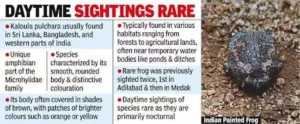
- Kawal Tiger Reserve:
-
- Location: Northeastern part of Telangana (Old Adilabad district). Bounded by the Godavari River on one side and the Maharashtra border on the other.
- Part of the Deccan peninsula-central highlands
- Rivers: Catchment area for the Godavari and Kadam rivers, which flow towards the south of the sanctuary.
- Connectivity: It has connectivity to the Tadoba-Andhari Tiger Reserve of Maharashtra in the north and to the Indravati Tiger Reserve of Chhattisgarh towards its north-eastern side.
- Vegetation: Southern Tropical Dry Deciduous Forest. The wildlife sanctuary is a dry and dense forest with teak, bamboo and many other varieties of trees.
- Fauna: Kawal has a faunal diversity which is typical of the Deccan Plateau.
- The sanctuary houses several species of animals including Cheetal, Sambar, Barking Deer, Nilgai, Sloth Bear, Indian Bison, Panther and Tiger.
- Flora: Important plant species are Anogeissus latifolia, Mitragyna parviflora, Terminalia crenulata, Terminalia arjuna, Boswellia serrata, Sterculia urens etc.
-
Indian Army’s Skin Bank
- News: The Indian Army has launched a first-of-its-kind skin bank facility for burn victims.
- Introduction: First-of-its-kind initiative by the Indian Army
- Aim: To revolutionise the treatment of severe burn injuries and other skin-related conditions for service personnel and their families.
- Function: This bank will serve as a centralised hub for the collection, processing, storage and distribution of skin grafts, providing a “critical resource” for military medical centres across the country.
- What is a Skin Bank?
-
- A skin bank is a specialized facility that collects, processes, and stores skin grafts for medical use. Here are the key aspects of a skin bank:
- Skin Donation:
- Skin can be donated by an eligible donor within six hours after death.
- Donations are accepted from anyone irrespective of sex and blood group, with a minimum donor age of 18 years.
- Skin donors must not suffer from AIDS, Hepatitis B & C, sexually transmitted diseases, skin cancer, active skin diseases, or septicemia.
- Processing and Storage:
- Donated skin undergoes a processing period of five to six weeks.
- The processed skin is preserved in an 85% glycerol solution.
- Stored at temperatures between 4-5 degrees Celsius, the skin can be preserved for up to five years.
- Usage: When a burn victim requires skin for their injuries, a surgical procedure called skin grafting is conducted using the stored skin.
-
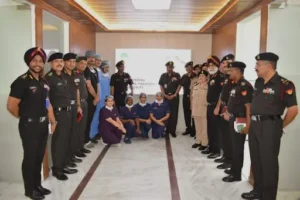
- What is Skin Grafting?
-
- Definition: Skin grafting is a medical procedure where a piece of healthy skin is transplanted to an area of the body where the skin is damaged or missing.
- This process is essential for treating extensive wounds, burns, and other severe skin injuries.
- Types of Skin Grafts:
- Autograft: Skin is taken from another part of the patient’s own body.
- Allograft: Skin is taken from a donor, often sourced from a skin bank.
- Time Duration: Skin from a deceased person can be donated within six hours after death and is processed over five to six weeks.
- Procedure: The procedure involves harvesting the upper layer of skin from one part of the body to cover a wound on another part. The donor site typically heals within 10 to 15 days.
-
Innovations for Defence Excellence (iDEX)
- News: The Ministry of Defence has signed 350th contract under iDEX for miniaturised satellite.
- Overview:
-
- Innovations for Defence Excellence (iDEX) is the flagship initiative of the Union Ministry of Defence, aimed at fostering self-reliance and innovation in the Defence and Aerospace sectors.
- It engages industries, including MSMEs, start-ups, individual innovators, R&D institutes, and academia, to drive technological advancements.
-
- Partnerships and Support:
-
- iDEX collaborates with leading incubators across the country.
- Provides handholding, technical support, and guidance to the winners of iDEX challenges.
-
- Funding and Management:
-
- Funded and managed by the Defence Innovation Organization (DIO).
- DIO is a not-for-profit company formed under Section 8 of the Companies Act 2013 by two Defence Public Sector Undertakings (DPSUs), HAL and BEL.
- iDEX functions as the executive arm of DIO, conducting all necessary activities while DIO provides high-level policy guidance.
- Financial support is provided to start-ups, MSMEs, individual innovators, and partner incubators through DIO.
-
- Initiatives and Achievements:
-
- Launched 11 editions of the Defence India Start-up Challenge.
- Recently unveiled the Acing Development of Innovative Technologies with iDEX (ADITI) scheme to promote innovations in critical and strategic defence technologies.
- Recipient of the Prime Minister Award for Public Policy in the Innovation Category in 2021.
- Engaged with over 400 start-ups and MSMEs.
-
Read also: Urban fires in India: Concept, Causes, Effects and Mitigation | UPSC
African Swine Fever
- News: 3,350 pigs have been killed by African Swine Fever disease in Mizoram.
- African Swine Fever (ASF)
-
- ASF is a highly contagious viral disease affecting domestic and wild pigs.
- Mortality rate can reach 100%.
-
- Virus Characteristics:
-
- The ASF virus is a large, enveloped, double-stranded DNA virus.
- This virus is the sole member of the genus Asfivirus within the family Asfarviridae.
-
- Symptoms: Similar to those of classical swine fever: fever, weak pigs, lack of appetite, inflamed eye mucous membranes, red skin, (bloody) diarrhea, and vomiting.
- Transmission:
-
- Direct Contact: With infected animals.
- Indirect Contact: Through ingestion of products from infected animals, contaminated clothing, vehicles, or equipment.
- Bites: By infectious soft ticks (where present).
- The virus can survive for long periods in pork and pork meat products.
-
- Geographical Spread:
-
- Endemic to sub-Saharan Africa.
- Spread to many regions, including Asia and Europe.
- In India, first confirmed in Arunachal Pradesh and Assam in February-March 2020.
-
- Impact:
-
- The virus does not affect people and there is no impact on human health.
- It has devastating effects on pig populations and the farming economy.
-
- Control Measures:
-
- No cure or approved vaccine available.
- Prevention relies on culling infected animals to stop the spread.
-
Exercise HOPEX
- News: The Indian Air Force’s (IAF) Rafale fighter jets are currently in Egypt for Ex- HOPEX.
- Participants: Air Forces of India and Egypt
- Aircraft Involved:
-
- C-17: Globemaster III, a large military transport aircraft.
- IL-78: Aerial refueling tanker and transport aircraft.
- Rafale: Multirole fighter aircraft.
-
- Location: Egypt

